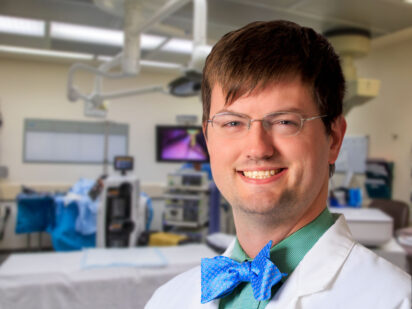Vitreoretinal Surgeon Comes Home to Minot
As one of only two vitreoretinal surgeons in western North Dakota, Robert Gokey, MD, understands that a significant part of his job is showing up in critical situations to perform a surgical intervention when a person’s eyesight is on the line.
Thanks to exceptional training and a remarkable upbringing, he is well-suited to meet the challenge.
Since joining Trinity Health this summer, Dr. Gokey has become the embodiment of three generations of physicians from his family tree to serve the Minot region. His grandfather, Dale B. Flickinger, MD, touched the lives of many during his 36-year career as a general surgeon. His mother, Susan Gokey, MD, served as an emergency physician with Trinity Health for many years. Now it’s the grandson’s turn to take up the mantle. “I’m proud to carry on my family’s legacy and feel blessed to have an opportunity to give back to the community that raised me,” he said.
As Dr. Gokey has moved about Trinity Health’s care system, he is regularly reminded of his family history. The D.B. Flickinger Surgical Center is the centerpiece of Trinity’s new Healthcare Campus and Medical District. Dr. Gokey also carries with him a pediatric stethoscope that belonged to his grandfather. But despite the imposing presence of the family patriarch, it’s his mother, Susan Gokey, who’s had the greatest influence on him.
“My mom took care of us during the day and worked at night,” the son recalls appreciatively. “She accomplished this by sleeping very little, and she did that for a very long time. I’ve internalized that a bit. When I’m not at work I try to be there for my kids, and the second they go to sleep – well, that’s the time when you get stuff done.”
Dr. Gokey long imagined he would follow in his mother’s footsteps and become an emergency physician. As an undergraduate he worked in the Trinity Emergency Trauma Center as a ward secretary for a time. Later, as a third-year medical student at the University of North Dakota, he almost seemed headed toward becoming an Infectious Disease specialist. Then, one of his rotations put him in contact with a Fargo ophthalmologist.
“I got to try ophthalmology at the Fargo VA with Dr. Hope Yongsmith and was able to witness cataract surgery,” he recalls. “That was the first time I’d really gotten to see that in ophthalmology, you can take a lot of people who aren’t seeing and make them see, which is magic.”
Shadowing Trinity Health’s Vitreoretinal Surgeon, David Jacobs, MD
He rotated over the holidays with Trinity Health ophthalmologists Darrell Williams, MD, and Chad Wolsky, MD, and also with David Jacobs, MD, Trinity’s vitreoretinal surgeon at the time. He got to observe Dr. Jacobs perform a vitrectomy, a surgery that Dr. Gokey now does routinely. “I felt like that was the first time I’d truly seen the back of an eyeball. It kind of felt like the moon landing to me.”
He completed his ophthalmology residency at Ochsner-Louisiana State University Shreveport and went on to accomplish his fellowship in vitreoretinal surgery at the University of Missouri, Columbia. During his fellowship he was able to train with a colleague of none other than Robert Machemer, a German-American ophthalmologist who is often called the father of modern retinal surgery.
Now, Dr. Gokey is a board-certified ophthalmologist and vitreoretinal surgeon, fully qualified to perform the full range of delicate surgical procedures deep inside the eye’s interior. His goal is always to restore, preserve and enhance vision for eye conditions such as certain types of age-related macular degeneration, diabetic retinopathy, diabetic vitreous hemorrhage, macular hole, detached retina and others.
Helping patients with retina conditions
“The coolest thing is being able to help someone who comes in with a retina entirely detached,” Dr. Gokey explains. “The lights are almost completely out except for a tiny spot where they might still be able to see. The next day, they’ve got a gas bubble in their eye.” Gradually the bubble is absorbed, then: “It’s like cured blindness,” he says. “It’s just remarkable.”
While most conditions managed by retinal doctors are due to the aging process, they also treat their share of trauma cases. As a result, they are good ambassadors for campaigns that urge caution when using fireworks or wearing appropriate safety glasses while working at home or on the job.
“The world can be a bit cruel and random,” Dr. Gokey states, “but sometimes you absolutely win. I had the privilege of being involved in a few cases where people’s eyeballs had pieces of metal go through them. They basically showed up blind. Two of them ended up with 20/20 vision, and one ended up 20/40. That is unreal. When you present as not being able to see motion after ocular trauma, your chances of maintaining better than legal blindness are less than 10 percent. I was blessed to take care of three of them who did so well. When you experience something like that, it’s just so rewarding.”




